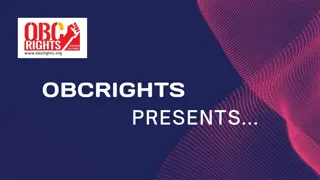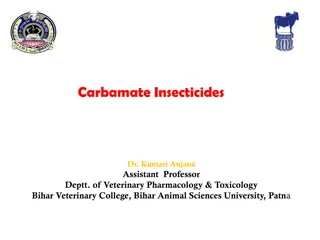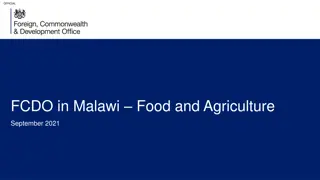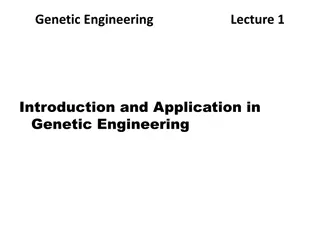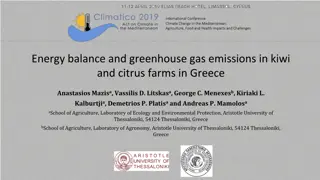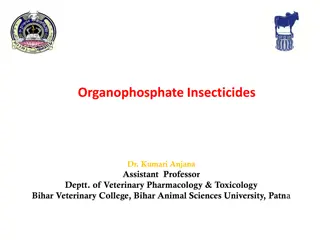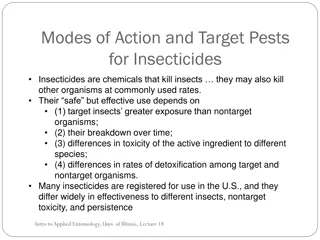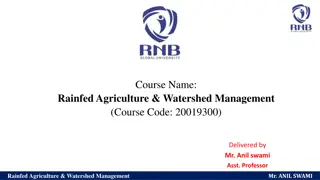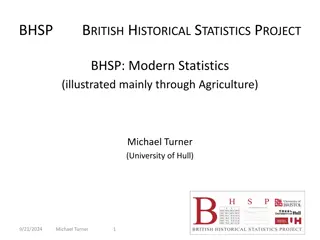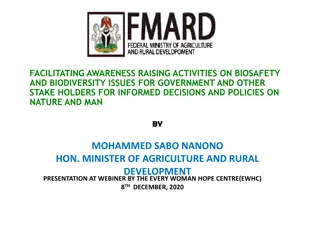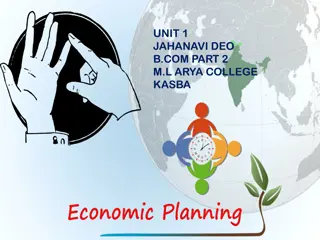Understanding the Use of Insecticides in Agriculture
This lecture on how insecticides are used in applied entomology covers the application of soil-applied and seed-treatment insecticides for controlling pests in crops, vegetables, fruits, and gardens. It discusses the types of insecticides, their persistence, solubility, and historical issues. Furthermore, it explores the use of seed-applied insecticides to protect seeds and seedlings from pests efficiently.
Download Presentation

Please find below an Image/Link to download the presentation.
The content on the website is provided AS IS for your information and personal use only. It may not be sold, licensed, or shared on other websites without obtaining consent from the author. Download presentation by click this link. If you encounter any issues during the download, it is possible that the publisher has removed the file from their server.
E N D
Presentation Transcript
HOW INSECTICIDES ARE USED Intro to Applied Entomology, Lecture 19
I. Soil-applied & seed-treatment insecticides Soil-applied for residual control: Applied to kill insects in treated soil at time of application and for a period up to several weeks later; incorporated (at least lightly) or injected to mix with soil Applied at planting for control of rootworms, cutworms, wireworms, grubs, seed and root maggots, etc. in field crops, vegetables, small fruits, gardens Applied as soil treatments for termite control around houses, other buildings Examples: Organophosphates: Lorsban/Dursban, Counter, Diazinon Pyrethroids: Force, Fortress Band applications instead of broadcast applications are most common in crops Intro to Applied Entomology, Lecture 19
I. Soil-applied & seed-treatment insecticides Soil-applied residual insecticides Typically have (or should have) half-lives of (very roughly) 30 to 90 days Typically are low to very low in water solubility (so that they do not leach out of the treatment zone in spring rainfall) Are not bound too tightly to soil particles as to be unavailable in contact with insects Historic problems have included too-great persistence (aldrin, dieldrin, heptachlor, chlordane, and other organochlorines) and too-great solubility and too little persistence (enhanced degradation of carbofuran / Furadan) Intro to Applied Entomology, Lecture 19
I. Soil-applied & seed-treatment insecticides Seed-applied residual insecticides Insecticides applied to seed at seed company facility or as a planter-box mixture Kill insects that feed directly on seeds and below-ground portions of seedlings Common seed protectants have included diazinon, Lorsban, lindane, and permethrin Targets: seedcorn maggot, other seed and root maggots, wireworms, white grubs, seedcorn beetles, and symphylans IF effective, seed treatments are appealing because they use a lot less insecticide than band or broadcast applications Intro to Applied Entomology, Lecture 19
I. Soil-applied & seed-treatment insecticides Soil-applied for systemic uptake Applied at planting or transplanting or as a side-dress Historically in IL: Furadan and Thimet in corn, cucurbits, and/or potatoes for control of flea beetles, cucumber beetles, Colorado potato beetle, or aphids feeding on foliage Elsewhere: Temik and Di-Syston in potatoes, (citrus), and wheat problems with leaching into groundwater Currently: Neonicotinoids such as Admire (imidacloprid) and Platinum (thiamethoxam) in similar crops against similar pests and in urban use for tree and shrub insect control Control usually begins a few days after application and persists 2 to 4 weeks; somewhat dependent on precipitation; neonicotinoids used around trees and shrubs may remain active for a year or more Intro to Applied Entomology, Lecture 19
I. Soil-applied & seed-treatment insecticides Seed-applied for systemic uptake Old O-Ps and carbamates that are systemic were not used as seed treatments because they were phytotoxic (poisonous to the seeds) Current systemic seed treatments are sold under the trade names Cruiser, Gaucho, and Poncho all are neoniconitoids On field crops, vegetables, and some ornamental plants Targets include bean leaf beetle, corn flea beetle, cucumber beetles, leafhoppers, and aphids for 1 3 weeks after seedling emergence Greater persistence and off-target movement may pose risks to pollinators Intro to Applied Entomology, Lecture 19
II. Soil fumigants Primary fumigant against insects, pathogens, and weeds in the soil is methyl bromide Applications usually made to raised beds tarped with plastic (for specialty crops) Fumigant gas kills organisms present at the time of fumigation; dissipates in a few days Cost = several hundred dollars to $2,000 per acre In IL, crops are plasticulture strawberries; some peppers and tomatoes Soil fumigation is rare in IL, but in FL, TX, and CA (and a few other areas), fumigating before planting high-value fruits and vegetables is common. Phase-out of methyl bromide because of its ozone-depleting effects presents a major challenge Intro to Applied Entomology, Lecture 19
III. Foliar-applied insecticides Foliar knock-down insecticides (with little or no residual control intended) Very few insecticides are applied with the intent that they NOT last at least a few days, but insecticides that kill only the insects that are present at the time of application or persist for only a short time include: dormant oils, soaps, pyrethrins, and malathion. Most insecticides that break down rapidly have short preharvest intervals; this can be especially important in fruits and vegetables where control may be necessary right up to the time the crop is picked. Intro to Applied Entomology, Lecture 19
III. Foliar-applied insecticides Foliar residual insecticides Most applications of insecticides to plant foliage, by aerial or ground sprayers, are intended to last for a few to several days as residues on plant foliage Most last from 3 to 10 days as effective residues Treatments remain effective if sprays dry before rainfall of up to 1 inch In general, most foliar residual sprays are effective as contact poisons insects that crawl across treated surfaces are killed when insecticides are absorbed through the insect s cuticle Intro to Applied Entomology, Lecture 19
IV. Animal insecticides Insecticides are applied directly to animals for control of lice, flies, grubs, ticks, mites, mosquitoes, etc. Application methods for residual insecticides include: Self-treatment devices such as back rubbers and dust bags Controlled-release devices such as ear tags and flea collars High-pressure sprays and mists Pour-on on spot-on treatments that distribute in the coat Application methods for systemic insecticides include: Pour-ons and spot-ons Feed additives Injections Intro to Applied Entomology, Lecture 19
V. Surface residual sprays Surfaces may be barn walls, bin walls, baseboards, wall voids, carpets, and more Sprays applied to barn walls, wooden fences, etc. for fly control Empty-bin sprays applied to grain bin walls for control of weevils, bran bugs, Indianmeal moth, etc. Baseboard sprays and wall void treatments for cockroach control Foundation and crawl-space sprays to control crickets, other invaders Intro to Applied Entomology, Lecture 19
VI. Aerosol space sprays Examples include bombs for flea control, mists for fly control in livestock buildings, aerosols in food processing plants often pyrethrins or pyrethroids with short residual and low toxicity These are not fumigants the active ingredient is dispersed in very small droplets of liquid that float through the air and deposit on exposed surfaces (including insects cuticles). They do not move as a gas into closed spaces such as cabinets, drawers, etc. Intro to Applied Entomology, Lecture 19
VII. Space and Commodity Fumigants Examples: methyl bromide, phosphine, chloropicrin, sulfuryl fluoride, and even carbon dioxide. In agriculture, used to disinfest stored grains, flour, flour mills and other food processing plants, and ripe fruits and vegetables (Mediterranean fruit fly and similar pests). In general, fumigants are EXTREMELY toxic and require special training and equipment for safe handling Intro to Applied Entomology, Lecture 19

 undefined
undefined





